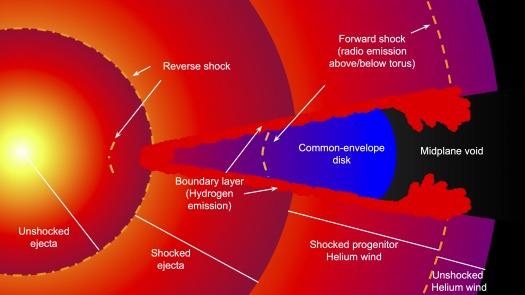An international team of astronomers headed by Dr. Benjamin Thomas of The University of Texas at Austin has utilized data from the Hobby-Eberly Telescope (HET) at the university’s McDonald Observatory to solve a puzzle regarding a star explosion that was detected some years ago and is still evolving. The findings, which were published in The Astrophysical Journal, will aid astronomers in understanding how big stars live and die.
 This schematic shows the various ejecta and winds (red and purple) given off by the exploding star (left, yellow). The common-envelope disk (blue) surrounds both stars, the one exploding as a supernova and its binary partner (not shown). The boundary layer around the common-envelope disk is the source of the hydrogen the team detected. Image Credit: B. Thomas et al. /UT Austin.
This schematic shows the various ejecta and winds (red and purple) given off by the exploding star (left, yellow). The common-envelope disk (blue) surrounds both stars, the one exploding as a supernova and its binary partner (not shown). The boundary layer around the common-envelope disk is the source of the hydrogen the team detected. Image Credit: B. Thomas et al. /UT Austin.
When an exploding star is discovered, scientists all around the world start tracking it with telescopes because the light it emits varies drastically over time. Scientists watch the light from a supernova become brighter, peak and then finally fade.
Researchers may determine the physical features of the system by recording the timings of these peaks and valleys in the brightness of the light, known as a “light curve,” as well as the distinctive wavelengths of light emitted at various times.
I think what’s really cool about this kind of science is that we’re looking at the emission that’s coming from matter that’s been cast off from the progenitor system before it exploded as a supernova. And so this makes a sort of time machine.
Dr. Benjamin Thomas, Postdoctoral Fellow, Department of Astronomy, The University of Texas at Austin
The progenitor of supernova 2014C was a binary star, which is a system in which two stars orbit each other. The companion star grew faster, expanded and lost its outer hydrogen blanket to the more massive star.
The inner core of the first star kept converting lighter chemical components into heavier ones until it runs out of energy. When that occurred, the star’s immense weight was no longer supported by the core’s outward pressure. The center of the star disintegrated, resulting in a massive explosion.
This classifies it as a “Type Ib” supernova, according to scientists. Type Ib supernovae, in particular, are distinguished by the absence of hydrogen in their ejected material, at least at first.
Since its discovery in 2014, Thomas and the research crew have been watching SN 2014C using telescopes at McDonald Observatory. Many other teams across the world have investigated it using ground- and space-based telescopes and other forms of light, like infrared light, radio waves from the ground-based Very Large Array, and X-Rays from the space-based Chandra Observatory.
However, the results of all of the observatories’ observations of SN 2014C did not add up to a consistent picture of how scientists thought a Type Ib supernova should act.
For one thing, the optical fingerprint from the Hobby-Eberly Telescope (HET) revealed that SN 2014C had hydrogen, which was a surprising discovery made by another team using a separate telescope.
Thomas added, “For a Type Ib supernova to begin showing hydrogen is completely weird. There’s just a handful of events that have been shown to be similar.”
For a second, the hydrogen’s optical brightness (light curve) was acting abnormally. >Almost all of the light curves from SN 2014C — radio, infrared and X-Rays — followed the predicted pattern: they became brighter, peaked and then began to decline. The optical light from the hydrogen, on the other hand, remained constant.
The mystery that we’ve wrestled with has been ‘How do we fit our Texas HET observations of hydrogen and its characteristics into that [Type Ib] picture?’.
Dr. J. Craig Wheeler, Study Team Member and Professor, Department of Astronomy, The University of Texas at Austin
The difficulty, as the scientists discovered, was that earlier simulations of this system assumed the supernova had detonated and blasted out a spherical shockwave. The HET results revealed that this theory was implausible, implying that something else must have occurred.
“It just would not fit into a spherically symmetric picture,” Wheeler stated.
The team suggests a model in which the hydrogen envelopes of the progenitor binary system’s two stars are combined to form a “common-envelope configuration,” in which both stars were confined within a single gas envelope. The two stars were subsequently surrounded by a spreading disk-like structure that ejected the envelope.
When one of the stars bursts, its rapid ejecta collided with the slow-moving disk, forming a “boundary layer” of intermediate velocity that moved over the disk surface. The researchers believe that this boundary layer is the source of the hydrogen that scientists discovered and examined with HET for seven years.
As a result, the HET data proved to be the key to unlocking the mystery surrounding supernova SN 2014C.
In a broad sense, the question of how massive stars lose their mass is the big scientific question we were pursuing, How much mass? Where is it? When was it ejected? By what physical process? Those were the macro questions we were going after. And 2014C just turned out to be a really important single event that’s illustrating the process.
Dr. J. Craig Wheeler, Study Team Member and Professor, Department of Astronomy, The University of Texas at Austin
Journal Reference:
Thomas, B. P., et al. (2022) Seven Years of SN 2014C: a Multi-Wavelength Synthesis of an Extraordinary Supernova. The Astrophysical Journal. doi.org/10.48550/arXiv.2203.12747.